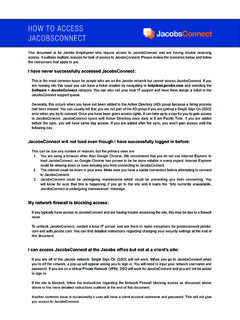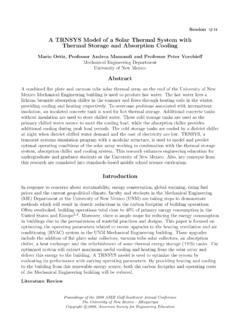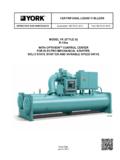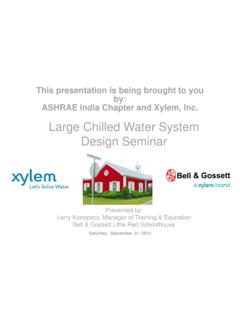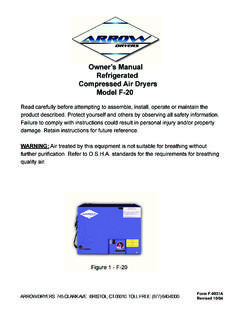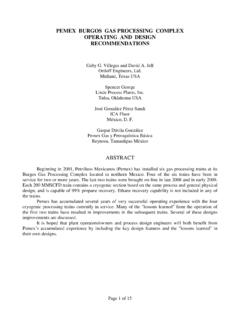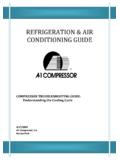Transcription of Risks of Accumulated Sulfur in SRUs May2013 final - Jacobs
1 Risks OF Accumulated Sulfur IN Sulfur RECOVERY UNITS By: Ellen Ticheler-Tienstra, Anne van Warners, Rien van Grinsven and Sander Kobussen of Jacobs Comprimo Sulfur Solutions Abstract While recovering Sulfur in an SRU depends on condensation of Sulfur , its unintended condensation and accumulation can present problems. The paper analyses areas where this may be expected and presents case histories of Sulfur build-up in SRU equipment, such as waste heat boilers, reheaters, Sulfur condensers and coalescers. The Risks involved in accumulation of Sulfur are discussed, both for the operation of Claus plants and for the operation of SUPERCLAUS plants, for which liquid Sulfur may pose extra Risks . Ways are discussed to prevent accumulation and minimize the Risks . This paper focuses on the most common type of SRU configurations, not on sub-dewpoint type SRUs. Introduction From time to time operational issues in an SRU are related to accumulation of liquid Sulfur .
2 These issues can be experienced in any SRU but operating experience over the past 25 years has shown that SUPERCLAUS and EUROCLAUS installations are sensitive to liquid Sulfur accumulation, as will be discussed below. In the modified Claus process, Sulfur is produced both in the thermal stage and in the catalytic stages. Since the Claus reaction is a chemical equilibrium, the production of Sulfur is inhibited if Sulfur vapor is already present in the process gas. Therefore a Sulfur condenser is generally used to condense and remove the produced Sulfur and ensure continued conversion to Sulfur in subsequent stage(s). As a general rule the Sulfur production is progressing as shown in table 1. This also shows the relative contribution of each stage to the total Sulfur production. Sulfur Production (%) Thermal stage First catalytic stage Second catalytic stage Third catalytic stage SUPERCLAUS stage Coalescer 3 stage Claus 2 stage Claus - This table is based on a typical refinery feed of 75 H2S, 5 NH3, 10 CO2, 10% H2O, C2H6 and almost complete removal of Sulfur vapor from the process stream.
3 The condensers are not removing all of the Sulfur , it is sufficient to stay above the Sulfur dew point in the following catalytic stage. In the sub-dewpoint processes (CBA, Sulfreen, MCRC) there is some deliberate condensation of Sulfur to below the dewpoint to force the Claus equilibrium closer to completion. Fire risk of Accumulated liquid Sulfur Principles of a Sulfur fire The best known risk of Accumulated liquid Sulfur is that of a Sulfur fire. For this to happen, air (or better: oxygen) has to be present in sufficiently high concentrations (>10%). At lower concentrations of free oxygen in the process gas the Sulfur will be oxidized to SO2 thereby generating extra heat of oxidation. A Sulfur fire can also lead to corrosion that is higher than normally experienced. Besides Sulfur vapor (from liquid Sulfur ) and oxygen in sufficiently high concentrations (>10 ) there has to be an ignition source.
4 The following sources have been identified: No additional source, when the temperature in the process at that point is above the auto-ignition temperature of Sulfur . The auto ignition temperature most often mentioned is 230 C but values ranging from 190 C to 261 C have been reported, possibly linked to the Sulfur particle size. Pyrophoric iron sulfide (FeS), when exposed to air (oxygen) will ignite a Sulfur /air mixture Static electricity generated by liquid Sulfur agitation. Sulfur , being one of the best electric insulating liquids known, and having a high dielectric constant can easily generate enough static electricity to cause a spark ignition Oxygen concentration during normal SRU operation During normal operation of a Claus unit with a good quality main burner hardly any oxygen will slip from the main combustion chamber to the catalytic stages, therefore the process gas does not contain free oxygen and there is no risk of a Sulfur fire.
5 During normal operation (the risk of) oxygen ingress arises from air instead of nitrogen purges on the main burner, fuel gas fired direct reheaters (inline burners) and in the SUPERCLAUS process, where air is introduced to selectively oxidize H2S to elemental Sulfur . The oxygen concentrations in these cases are limited and will not lead to Sulfur fires. In case of a SUPERCLAUS or EUROCLAUS installation, oxygen concentration is designed to be just enough to convert H2S and keep the catalyst in an oxidized state. In the reactor outlet there should be just to oxygen present. Oxygen concentration during abnormal SRU operation The risk of a Sulfur fire increases as soon as higher concentrations of oxygen enter the system. This happens most often when the main burner is in the start-up phase and/or operated with fuel gas, during heating up, hot standby or during taking the unit out of operation, when the burner is operated not substoichiometrically, but with excess air.
6 In the first two modes of operation (heating up with Sulfur in the unit and hot standby) this is due to wrong setting of the air to fuel gas ratio. This can occur easily, when the main burner is not operated with a fuel gas of constant composition (preferably natural gas), but with a fuel gas of varying composition (and Mol. Weight, which leads to wrong fuel gas flow metering). A fuel gas analyzer ( Wobbe index meter) could be installed to compensate for fluctuations in fuel gas composition and air demand. In the last mode of operation (taking the unit out of operation for maintenance), it is the intention to gradually convert FeS to Fe2O3 in a controlled way by increasing the oxygen slip from the main burner. Oxygen concentration during abnormal SUPERCLAUS operation In the selective oxidation stage of a SUPERCLAUS plant, higher concentrations of oxygen can be present during heating up or shutting down or during a bypass of the selective oxidation stage.
7 A bypass of the selective oxidation stage occurs on high temperature in the catalyst bed or on high inlet H2S concentration and protects the selective oxidation stage during upsets, preventing too high temperatures in the reactor. In such a case the reactor temperature is maintained by purging the reactor with air. This also keeps the catalyst under oxidizing conditions and prevents ingress from Sulfur containing tail gas via the back-end of the selective oxidation stage. So, during a bypass the atmosphere in the selective oxidation stage contains 20% oxygen. When this atmosphere comes in contact with any Accumulated Sulfur in the piping or equipment (reheater, condenser, coalescer) then there is an increased risk of fire. As to liquid Sulfur , it is important to note that the selective oxidation catalyst does not retain liquid Sulfur in its pores, unlike Claus catalyst. So Sulfur in the selective oxidation catalyst does not contribute to the risk of a Sulfur fire.
8 An obvious result of a Sulfur fire is damage to equipment. Condenser tubes and mist pads are especially vulnerable. Sometimes the fire is limited, either by available Sulfur or oxygen, and will give a noticeably higher temperature but no damage. Note however, that in every Sulfur fire not only SO2 but also SO3/sulfuric acid will be produced. Sulfuric acid can eventually lead to extensive corrosion damage in lines and equipment. Other effects of Accumulated liquid Sulfur Besides the risk of a Sulfur fire there are other effects of accumulation of Sulfur . When the level of stagnant Sulfur has risen high enough, it will impede the flow of process gas and cause pressure drops forcing lower gas feed rates. A sudden limitation to the capacity or an increased main burner inlet pressure may be a sign of Sulfur accumulation. Yet a normal inlet pressure is no guarantee that there is no Sulfur accumulation. If there is a pool of liquid Sulfur , the flow of process gas can entrain liquid Sulfur , carrying it downstream in the form of mist or even slugs of liquid Sulfur .
9 An illustration of this effect is the upward flow of raindrops on the windscreen of a car above a certain speed. In downstream equipment, the Sulfur can be knocked out and will accumulate at low points in the unit. This results in a pool of liquid Sulfur , when the Sulfur cannot be drained properly. In this respect it is relevant to mention that agitation of liquid Sulfur by the process gas flow can generate static electricity and act as an ignition source, as described before. Another effect of entrained Sulfur is obstruction of lines or demister pads. Entrained Sulfur has been found to plug instrument lines and even tail gas analyzers. Also the efficiency of demister pads can be compromised by accumulation of Sulfur in the pad. Furthermore, a nowadays not unimportant side-effect of entrained Sulfur reaching the incinerator is a higher stack SO2 emission. Finally, when an installation containing liquid Sulfur is allowed to cool, the Sulfur will solidify and mechanically removing the solid Sulfur in lines and equipment can be very difficult and time consuming.
10 Case histories It is believed that Sulfur accumulation as described in this paper occurs widely, but is often not identified or recognized in a Claus unit. In the case histories below, several incidents in the Claus stages and in the selective oxidation stage of SUPERCLAUS installations are described. It will however be clear that this type of incidents is in no way unique for SUPERCLAUS . Case 1: Refinery application, 3 stage Claus unit Description: The unit was operating fine but because of a small instrument problem the acid gas was shut down and the unit was operated in hot standby mode. After approx. 30 minutes a Sulfur fire was seen in the first reheater. This is a general SRU case. Cause: Sulfur had Accumulated in the first reheater and could not drain because of a wrong slope of the reheater. Also the sliding strips in the reheater shell prevented proper draining of Sulfur . In hot standby mode, the air/fuel gas ratio was too high and consequently air contacted the Accumulated Sulfur .



